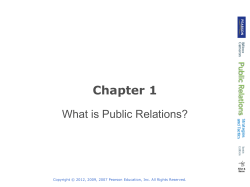
Chapter 12 Reference Groups and Family Consumer Behaviour Canadian Edition
Chapter 12 Reference Groups and Family Consumer Behaviour Canadian Edition Schiffman/Kanuk/Das Copyright © 2006 Pearson Education Canada Inc. What is a Group? Two or more people who interact to accomplish either individual or mutual goals Copyright © 2006 Pearson Education Canada Inc. 12-2 Reference Group A person or group that serves as a point of comparison (or reference) for an individual in the formation of either general or specific values, attitudes, or behaviour. Copyright © 2006 Pearson Education Canada Inc. 12-3 Types of Reference Groups Classified by: – Membership • Symbolic – Extent of interaction • Direct versus indirect – Nature of attraction • Aspirational versus dissociative – Degree of formality • Formal versus informal Copyright © 2006 Pearson Education Canada Inc. 12-4 Types of Reference Group Influence Informational Influence – When a member of reference group provides information used to make purchase decisions Normative Influence – When we conform to group norms in order to belong to that group Identification Influence – When we identify with, and internalize, a group’s values and behaviours Copyright © 2006 Pearson Education Canada Inc. 12-5 Factors Encouraging Conformity: A Reference Group Must ... Inform or make the individual aware of a specific product or brand Provide the individual with the opportunity to compare his or her own thinking with the attitudes and behaviour of the group Influence the individual to adopt attitudes and behaviour that are consistent with the norms of the group Legitimize the decision to use the same products as the group Copyright © 2006 Pearson Education Canada Inc. 12-6 Selected Consumer-Related Reference Groups Friendship groups Shopping groups Work groups Virtual groups or communities Brand communities Consumer-action groups celebrities Copyright © 2006 Pearson Education Canada Inc. 12-7 Copyright © 2006 Pearson Education Canada Inc. 12-8 Reference Groups and Marketing Strategy Recognize the extent of reference group influence in a situation Identify the most effective type of reference group influence Identify possible reference group members to use in promotions Attempt to increase reference group influence Copyright © 2006 Pearson Education Canada Inc. 12-9 Households Family Households: Married couple, Nuclear family, Extended family Households Non-Family Households: Unmarried couples, Friends/ Roommates, Boarders Copyright © 2006 Pearson Education Canada Inc. 12-10 The Typical Household? Canada: Nuclear family Thailand: Extended family USA: Not married, no children Copyright © 2006 Pearson Education Canada Inc. 12-11 The Family Life Cycle Traditional Family Life Cycle – – – – – Stage I: Bachelorhood Stage II: Honeymooners Stage III: Parenthood Stage IV: Post-parenthood Stage V: Dissolution Modifications - the Nontraditional FLC Copyright © 2006 Pearson Education Canada Inc. 12-12 Copyright © 2006 Pearson Education Canada Inc. 12-13 Figure 12-6 Noteworthy Nontraditional FLC Stages Alternative FLC Stages Definition/Commentary Family Households Childless couples It is increasingly acceptable for married couples to elect not to have children. Contributing forces are more career-oriented married women and delayed marriages. Couples who marry later in More career-oriented men and women and greater life (in their late 30s or later) occurrence of couples living together. Likely to have fewer or even no children. Couples who have first child Likely to have fewer children. Stress quality lifestyle: later in life (in their late 30s “Only the best is good enough” or later) Copyright © 2006 Pearson Education Canada Inc. 12-14 Figure 12-6 (continued) Alternative FLC Stages Family Households Single parents I Definition/Commentary Single parents II Young man or woman who has one or more children out of wedlock. Single parents III A single person who adopts one or more children. Extended family Young single-adult children who return home to avoid the expenses of living alone while establishing their careers. Divorced daughter or son and grandchild(ren) return home to parents. Frail elderly parents who move in with children. Newlyweds living with in-laws. High divorce rates (about 50%) contribute to a portion of single-parent households Copyright © 2006 Pearson Education Canada Inc. 12-15 Figure 12-6 (continued) Alternative FLC Stages Definition/Commentary Nonfamily Households Unmarried couples Increased acceptance of heterosexual and homosexual couples. Divorced persons (no children) High divorce rate contributes to dissolution of households before children are born. Single persons (most are young) Primarily a result of delaying first marriage; also, men and women who never marry. Widowed persons (most are elderly) Longer life expectancy, especially for women; means more over-75 single-person households. Copyright © 2006 Pearson Education Canada Inc. 12-16 Copyright © 2006 Pearson Education Canada Inc. 12-17 Dynamics of Husband-Wife Decision Making Husband-Dominated Wife-Dominated Joint – Equal – Syncratic Autonomic – Solitary – Unilateral Copyright © 2006 Pearson Education Canada Inc. 12-18 Consumer Socialization The process by which children acquire the skills, knowledge, and attitudes necessary to function as consumers. Copyright © 2006 Pearson Education Canada Inc. 12-19 Copyright © 2006 Pearson Education Canada Inc. 12-20 Other Functions of the Family Economic well-being Emotional support Suitable family lifestyles Copyright © 2006 Pearson Education Canada Inc. 12-21 Family and Marketing Strategy Use the FLC for segmentation and positioning Recognize the diverse consumption roles within the family Understand and use the dynamics of husband-wife decision making Understand and use the consumer socialization role played by the family Recognize the changing nature of Canadian families. Copyright © 2006 Pearson Education Canada Inc. 12-22
© Copyright 2025





















